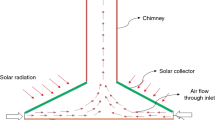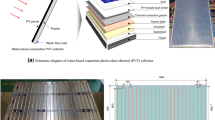Abstract
Solar thermal power is a promising and rapidly expanding source of carbon-free energy. Analysis and design techniques for solar thermal power generation for the Solar Power Tower (SPT) systems are currently mathematically difficult. We simulated a model of a SPT that advances the simulation of SPT performance by modelling them in Thermolib software. The model in this study simulates SPT with a direct steam generation system with design variables of 0.04 kg/s heat transfer fluid (HTF) flow rate at 6 bar operating pressure using water as HTF. The reaction to varied operating pressure, fluid flow rates, and insolation input has been analysed. The simulation results show that steam will be produced at 1–3 bar with maximum steam quality of 0.06, 0.02 and 0.0015, respectively. Lowering the HTF flow rates to 0.02 and 0.03 kg/s will produce steam with maximum quality of 0.15 and 0.028, respectively. Increasing the amount of heliostat from 15 to 20 in staggered formation results in a 14.5% increase in power received by the receiver, resulting in a maximum steam quality produced of 0.029. The analysis shows that high quality of steam can be achieved with a lower HTF flow rate and pressure, but it compromises the useful energy generated by turbine.
Access this chapter
Tax calculation will be finalised at checkout
Purchases are for personal use only
Similar content being viewed by others
References
Faye K, Thiam A, Faye M (2021) Optimum height and tilt angle of the solar receiver for a 30 kWe solar tower power plant for the electricity production in the Sahelian Zone. Int J Photoenergy 2021:1–14. https://doi.org/10.1155/2021/1961134
Kolb GJ, Ho CK, Mancini TR, Gary JA (2011) Power tower technology roadmap and cost reduction plan, 38
Luo Y, Du X, Yang L, Xu C, Amjad M (2017) Impacts of solar multiple on the performance of direct steam generation solar power tower plant with integrated thermal storage. Front Energy 11(4):461–471. https://doi.org/10.1007/s11708-017-0503-5
Xu R, Wiesner TF (2015) Closed-form modeling of direct steam generation in a parabolic trough solar receiver. Energy 79:163–176. https://doi.org/10.1016/j.energy.2014.11.004
Eck M, Steinmann WD (2005) Modelling and design of direct solar steam generating collector fields. J Sol Energy Eng-Trans ASME 127(3):371e80
Hirsch T, Eck M, Steinmann W-D (2005) Simulation of transient two-phase flow in parabolic trough collectors using Modelica. In: Proceedings of the 4th international Modelica conference, Hamburg, Germany
Eck M, Hirsch T (2007) Dynamics and control of parabolic trough collector loops with direct steam generation. Sol Energy 81(2):268e79
Silva R, Perez M, Fernandez-Garcia A (2013) Modeling and co-simulation of a parabolic trough solar plant for industrial process heat. Appl Energy 106:287e300
Roldan MI, Valenzuela L, Zarza E (2013) Thermal analysis of solar receiver pipes with superheated steam. Appl Energy 103:73e84
Yan Q, Hu E, Yang YP, Zhai RR (2010) Dynamic modeling and simulation of a solar direct steam-generating system. Int J Energy Res 34(15):1341e55
Martínez I, Almanza R (2007) Experimental and theoretical analysis of annular twophase flow regimen in direct steam generation for a low-power system. Sol Energy 81(2):216e26
Ritschel TKS, Gaspar J, Jørgensen JB (2017) A thermodynamic library for simulation and optimization of dynamic processes. IFAC-Papers OnLine 50(1):3542–3547. https://doi.org/10.1016/j.ifacol.2017.08.951
Thomson GH (1996) The DIPPRR© databases. Int J Thermophys 17(1):223–232
Peng D-Y, Robinson DB (1976) A new two-constant equation of state. Ind Eng Chem Fundam 15(1):59–64
Soave G (1972) Equilibrium constants from a modified Redlich-Kwong equation of state. Chem Eng Sci 27(6):1197–1203
Shibata SK, Sandler SI (1989) Critical evaluation of equation of state mixing rules for the prediction of high-pressure phase equilibria. Ind Eng Chem Res 28(12):1893–1898
Chapman JW, Lavelle TM, May RD, Litt JS, Guo T-H (2014) Toolbox for the modeling and analysis of thermodynamic systems (T-MATS) user’s guide. Technical report, NASA’s Glenn Research Center
Martín A, Bermejo MD, Mato FA, Cocero MJ (2011) Teaching advanced equations of state in applied thermodynamics courses using open source programs. Educ Chem Eng 6(4):e114–e121
Sundman B, Kattner UR, Palumbo M, Fries SG (2015) OpenCalphad—a free thermodynamic software. Integr Mater Manuf Innov 4 (1)
Simulink, & User (nd) Simulation toolbox for the Design and Development of Thermodynamic Systems in MATLAB. https://www.thermolib.de/media/thermolib/downloads/Thermolib-UserManual.pdf
Tempesti D, Manfrida G, Fiaschi D (2012) Thermodynamic analysis of two micro CHP systems operating with geothermal and solar energy. Appl Energy 97:609–617
Hossin K, Mahkamov K (2015) Performance evaluation for a 10 kW solar organic rankine cycle power system to operate in the UK climate conditions. https://doi.org/10.13140/RG.2.1.4135.4721
Thermolib. http://www.eutech-scientific.de/productsservices/thermolib.html
Acknowledgements
The author would like to thank Ministry of Science, Technology and Innovation (MOSTI) IF1020l1308 (cost centre 015ME0-217) and Yayasan Universiti Teknologi PETRONAS (YUTP) FRGS (cost centre 0153AA-H28) for providing financial support for this project.
Author information
Authors and Affiliations
Corresponding author
Editor information
Editors and Affiliations
Rights and permissions
Copyright information
© 2024 Institute of Technology PETRONAS Sdn Bhd (Universiti Teknologi PETRONAS)
About this paper
Cite this paper
Bin Abdullah, A.Z.A., Muhammad, M.D., Gilani, S.I.UH., Ali, M., Al-Kayiem, H.H. (2024). Thermal Analysis of Evacuated Tube Receiver for Solar Power Tower by Transient Simulation. In: Ahmad, F., Iskandar, T., Habib, K. (eds) ICREEM 2022. ICREEM 2022. Lecture Notes in Mechanical Engineering. Springer, Singapore. https://doi.org/10.1007/978-981-99-5946-4_13
Download citation
DOI: https://doi.org/10.1007/978-981-99-5946-4_13
Published:
Publisher Name: Springer, Singapore
Print ISBN: 978-981-99-5945-7
Online ISBN: 978-981-99-5946-4
eBook Packages: EngineeringEngineering (R0)




